If a plant has yellow drooping leaves, or the leaves have unsightly black or yellow spots, it may have root rot. Wondering how to fix root rot? Or What does root rot look like? Read on…
What is Root Rot?
Root rot is a disease affecting plant roots. This is a very common problem for houseplants and outdoor garden plants alike.
It is caused by pathogens, bacteria and fungi that live in the soil. These pathogens can infect weakened plant roots. But they don’t often harm healthy strong plant roots.
In weak plants the outer root, called the epidermis, is attacked first. The unhealthy root that succumbs will get necrosis and die. This leaves the inner cortex of the root undefended. So it also eventually dies. The roots can dry and shrivel. Or if the soil is wet they rot away into a blacked, smelly mess.
The disease will continue to spread throughout the whole root system and up the plant stem if left untreated. The plant will die in that case. However, the process can often be stopped with early intervention.
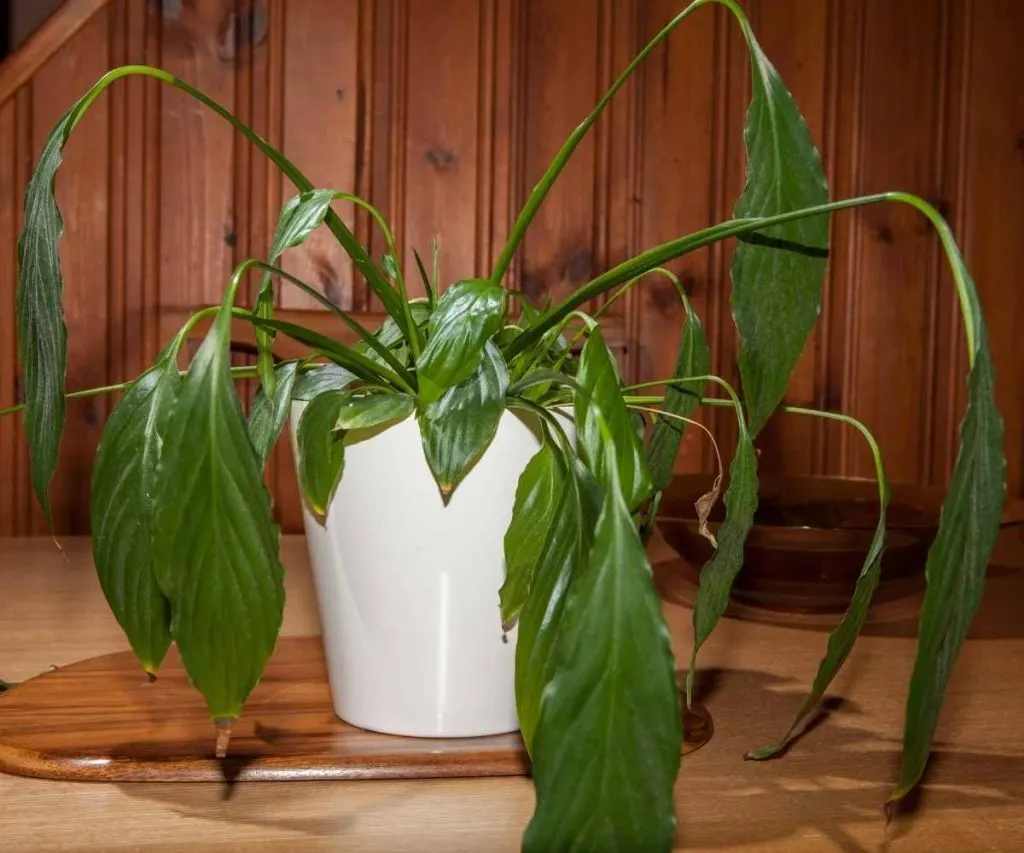
We don’t always see the damage until the plant is pretty sick. When you notice trouble start looking for answers!
If too many of the roots rot the plant can’t be fed. The plant top growth starts to stress. Leaves droop, yellow and eventually die of starvation.
It May not be Root Rot:
The leaf damage you see may not be all about root rot. Drooping or Yellowing leaves can also be caused by pests and other problems.
Don’t assume you have root rot until you un-pot your plant and check the root health.
Learn more about Pest infections and the Problems they cause our houseplants in our posts on Spider mites, Thrips, Mealybugs and aphids. They all contribute to plant stress in various ways.
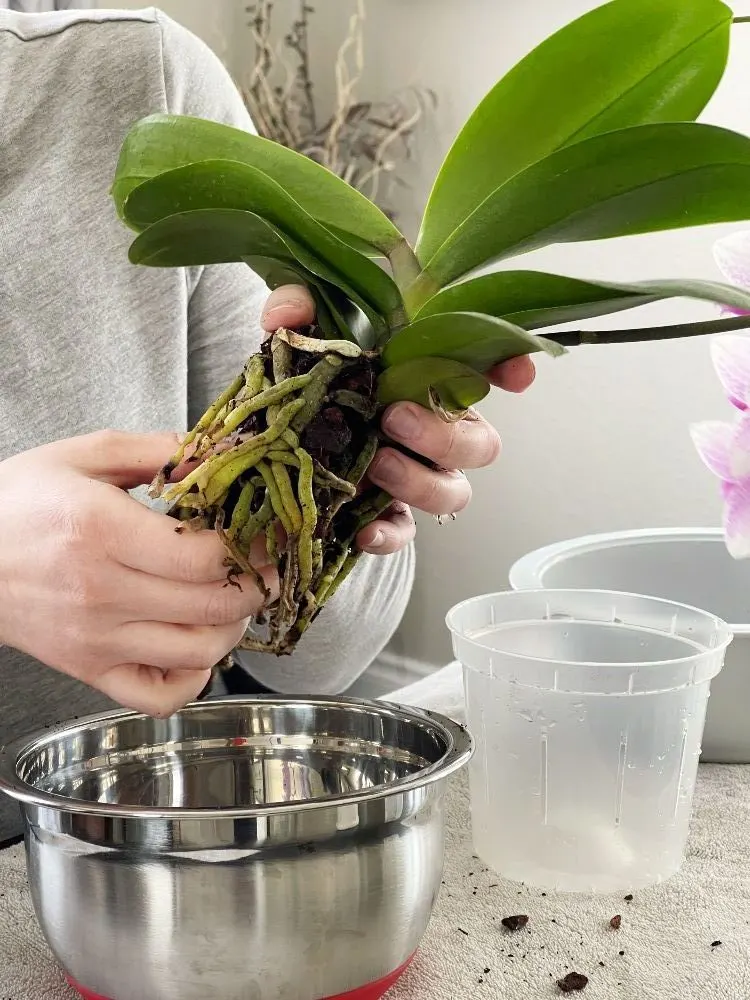
Learn more about Orchid Root Rot in this post
The Contented Plant
How do Plants get Root Rot?
Plants are exposed to air and soil borne fungus and bacteria all the time. Healthy plants have defenses that protect the roots.
Stressed plants from long term poor cultivation methods will eventually run out of defenses. Let’s look at some common plant stressors.
Over Watering is the major contributing factor to root rot in plants. Constantly too wet soil will suffocate the roots and damage them. Then the roots are very susceptible to the marauders in the soil.
- An over watered plant that has root rot disease actually dies of thirst and starvation. Because the roots can no longer feed the plant. The leaves show stress first and then the plant begins to die.
- To avoid over watering your plants or allowing them to get unevenly dry DO use a plant moisture meter. This handy and cheap tool will save your plants from your kind intentions.
- Use it in several places in the plant pot and sink it clear down to the roots. Thats where you need to know the moisture level of your soil.
- Learn what moisture your plant requires for healthy growing. And stick to a regular watering schedule.
- Keep the size of the plant pot a proper match for the root ball of your plant. Too big a pot will be wet longer after watering. Soggy soil is not good for roots and it promotes the fungi and bacteria that make roots rot.
More Contributing Factors:
- Under watering also can cause root rot in a different way. If the soil dries to the point of root death (even partial root death). The dead roots will rot. This is compounded when you resume watering. The dead roots decompose and spread disease to whatever healthy roots are left.
- Poor Draining soils: Heavy dense soils hold moisture and reduce oxygen to the plants roots.
- No drainage in Pots: Pots with no drain holes are very dangerous. If the water holds in the pot bottom it will encourage root rot.
- Soil (yes even purchased potting soils) may be inoculated with spores of various funguses and bacteria that can spread infection to the plant roots.
- Stress from shipping, Harsh chemical sprays, extreme temperatures and dehydration can harm plant roots.
Fungus Gnats:
If you overwater consistently fungus gnats will most likely move into your wet plant soil and set up house.
Fungus Gnats are common spreaders of fungal spores and infections. They pick up the fungus spores and distribute it to the stem, leaves and soil of your plants when they land.
Gnats complete their life cycle in your pot soil. Then they fly to your other plants as adults spreading disease and repeating their lifecycle.
Closely grouped plants are in danger of sharing these fungal infections spread by fungus gnats.
Learn more about fungus gnats and how to control them.
The Contented Plant
Signs of root rot:
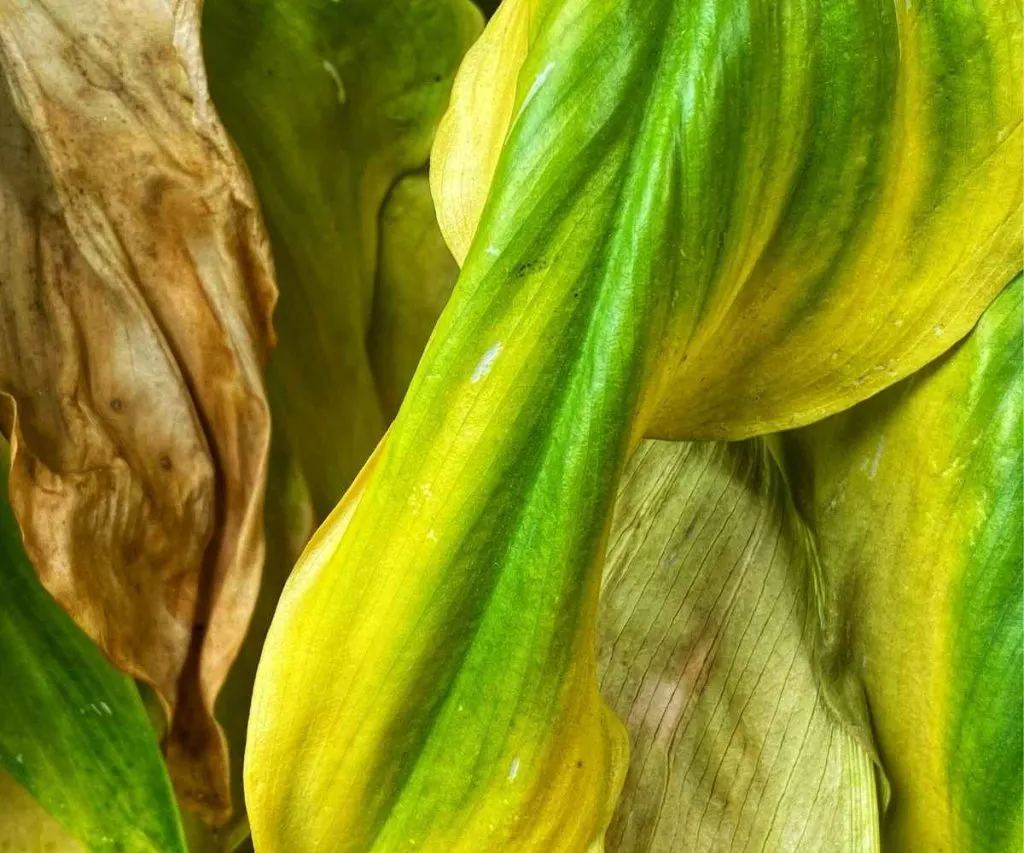
- Yellowing leaves, drooping leaves, leaves with black or yellow spots are all signs you need to check your root health. Especially if the soil is constantly wet.
- Unpot the plant and look at the roots.
- Dark brown or Black roots or roots spotted with dark spots are rotting
- Mushy roots. When you take hold of a root it should be firm. If the root dissolves or is mushy try to pull it. A rotted root will come apart in your fingers leaving only a thin string of the root cortex behind, if that.
- The root system may smell like rot.
Often not all of the roots are rotted. Don’t be confused if you see healthy roots. Be sure to remove the all the dirt from a sick plants roots. Check ALL the roots. This is a progressing problem. If you miss it it will get worse.
Examine the roots. Healthy roots are white or yellow depending on the growing medium. When you see black roots or roots with black spots on them this indicates root rot.
Feel the root. If your roots are mushy they are not feeding the plant. The root is also going to continue to degrade. The rot will spread through all the plant root eventually and even up the stem (or rhizome).
What Does Root Rot Look Like?
There are MANY fungus that can infect your plant roots and cause trouble. You most often won’t notice any trouble until the leaves show you. Learn to read the signs of trouble in your roots early so you can save your plants.
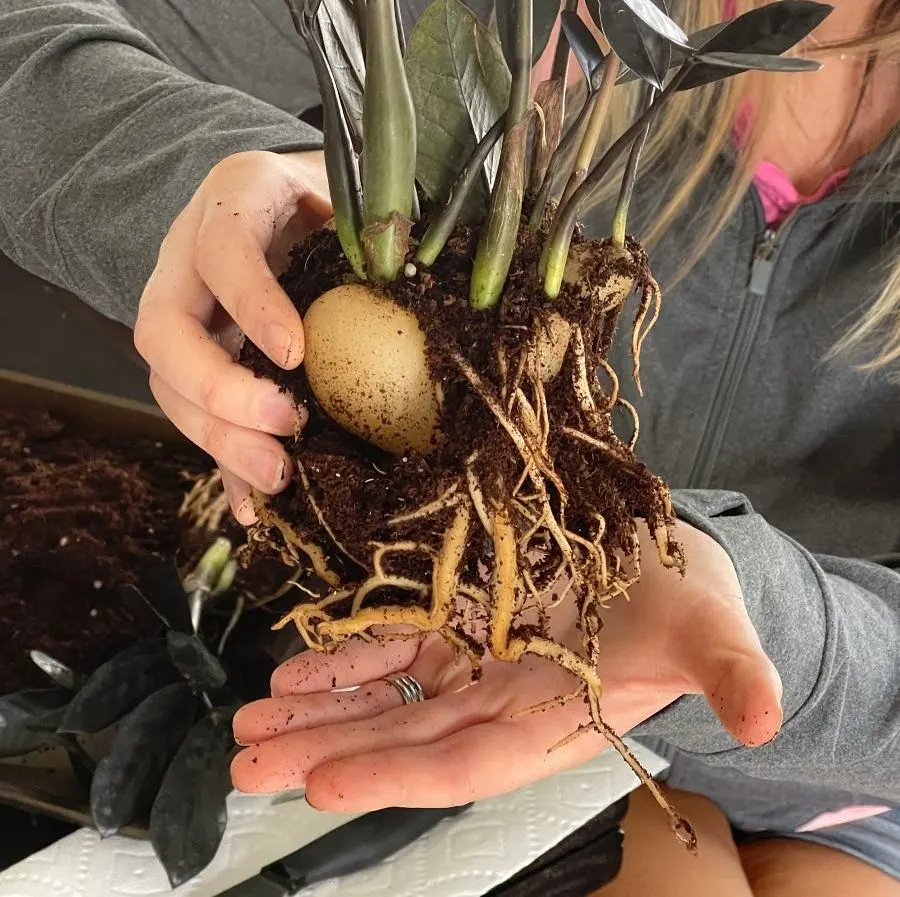
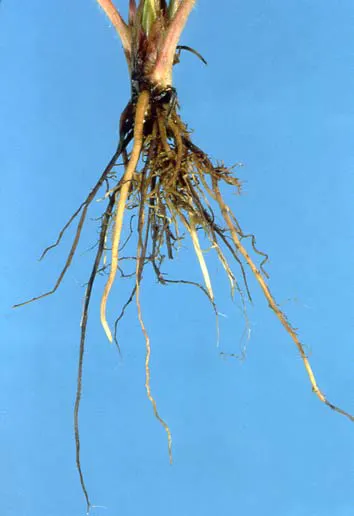
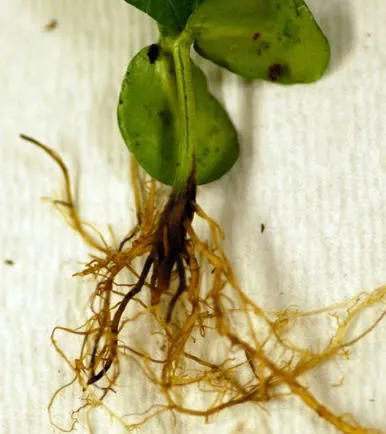
- The pictured ZZ plant has a wonderfully healthy root system. The roots are firm and light colored and the plant top growth is thriving and well fed by the roots. No problems in the roots here.
- The strawberry plant has Red Stele root rot. Notice the black roots mixed in with the light colored healthy roots? Often the roots are is some stage of rotting like this.
- The third picture is of fusarium Root rot in a soy bean plant. Note the black spots on the leaves of the plant. This is a telltale sign of an infection in your plant roots.
- The roots may also have black spots on them. The damage depends on what is attacking them.
- Shriveled dry roots are dead and ready to rot. They cannot feed the plant. But they can kill it with root rot.
Save your Plant:
If you treat the plant for root rot in the early stages you can often save the plant. Take action!

The orchid pictured above has healthy top growth. But some of the roots are dying and beginning to rot. This is the early stage of root rot. Notice the brown and dry roots? These are unhealthy rotting or dead roots. Orchid root rot is a common problem for orchid owners.
Follow the Process below to learn how to fix root rot and hopefully revive a plant sickened by rotted roots.
How to fix Root Rot
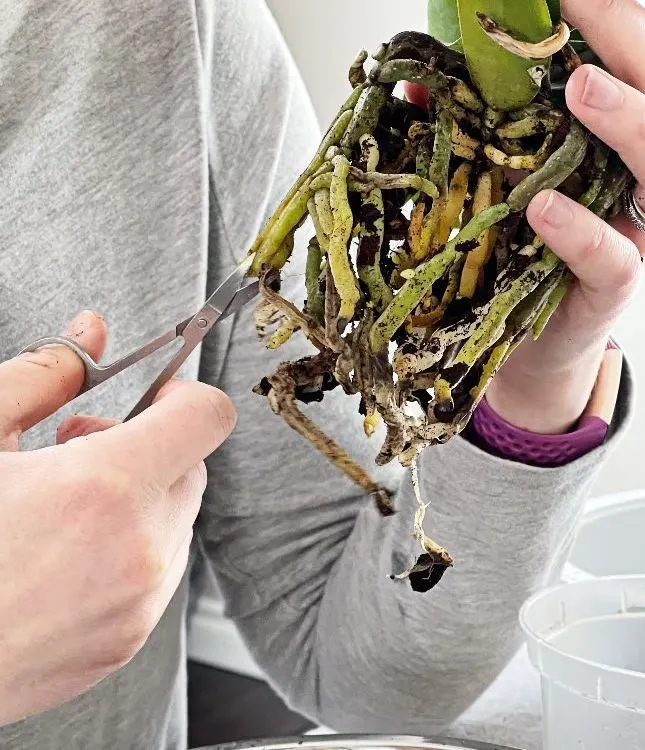
Use this process to clean up root rot in your plant. If the plant is strong enough it will make a full recovery.
Materials
- 3% hydrogen peroxide solution
- potting soil or preferred substrate
- clean filtered or distilled water
- Bleach (as an alternative to the hydrogen peroxide)
- Fungicide
Tools
- sterile scissors
- small hand pruners
- gloves
- clean bowl
- clean working surface or baking sheet
- sterile well draining plant pot
Instructions
Plant Prep:
- un-pot the plant from the old pot.
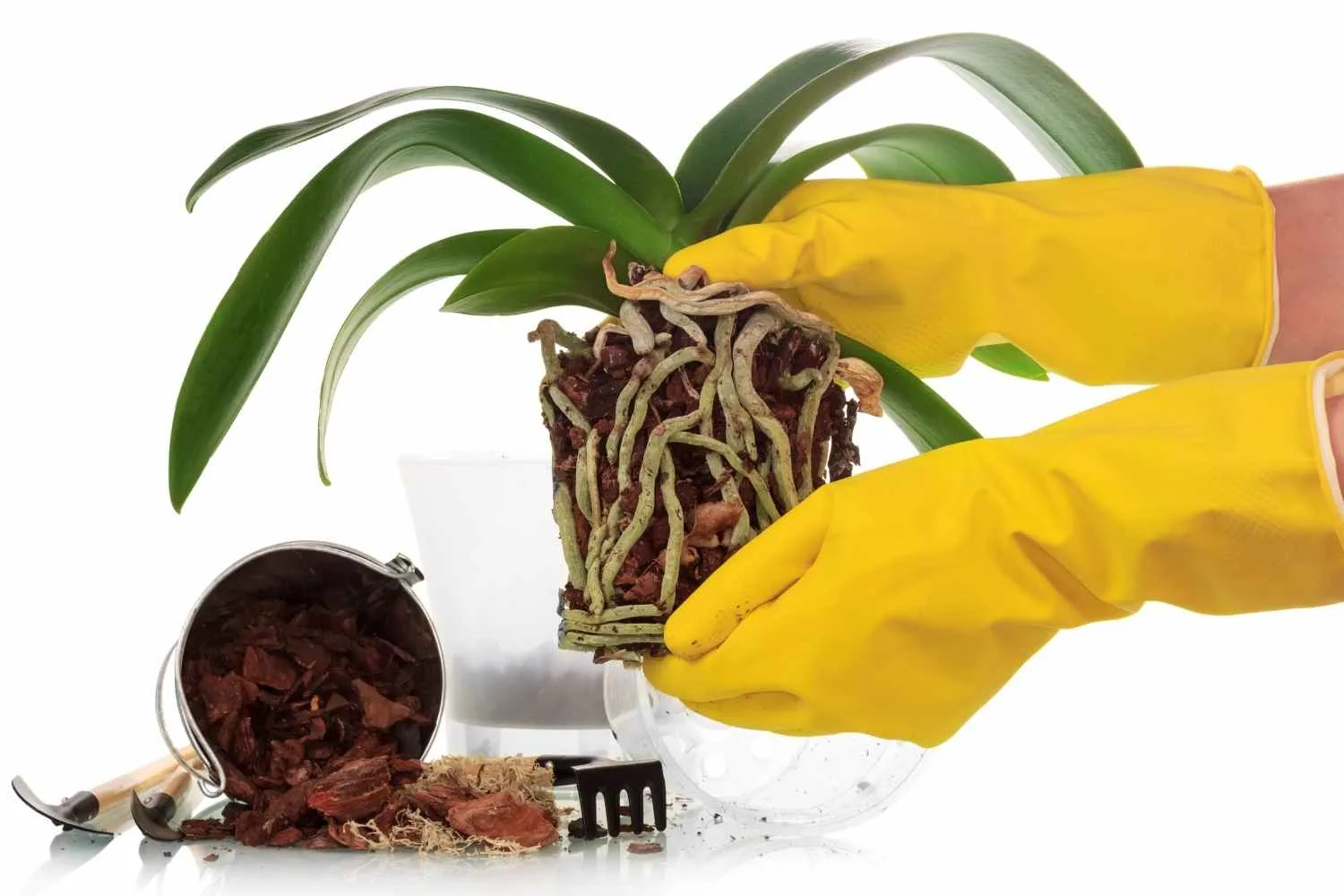
- with gloves on gently remove ALL the soil or other substrate from the roots.
- Rinse the roots until they are clean and free of all substrate.
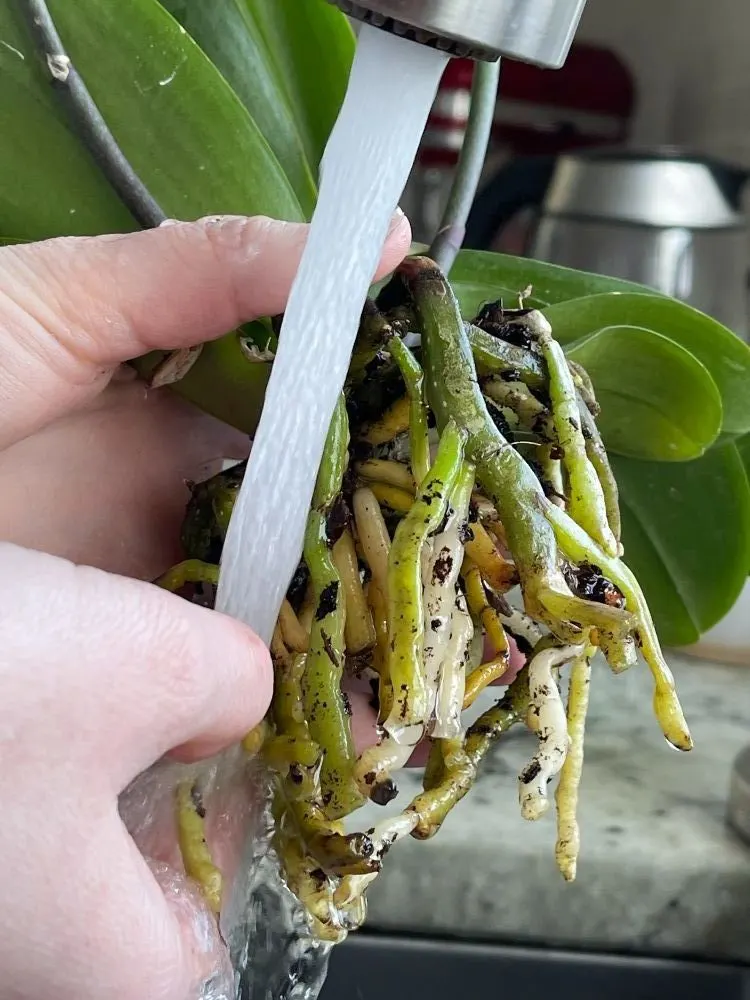
Trim the Roots:
- Find the rotted roots. They are easy to see as black or brown mushy roots. They may also be dead and dry and shriveled.

- Cut off ONLY the rotted part of the root and a bit higher on the root. Leave the healthy part of all the roots you can.
Make your Root Cleaning Solution:
- Hydrogen peroxide solution: Mix hydrogen peroxide to water in a 1:1 ratio. Mix the solution and pour into your clean bowl.
- ALTERNATIVELY: You may use 4 to 6 drops bleach to one quart of water as a dip solution to clean the roots.
Dip the roots:
- Immerse the clean and trimmed plant root system into the root cleaning solution. Make sure the roots are all treated then remove. "No soaking needed.
- You may treat the plant with a fungicide at this point if you wish.
Repot:
- You MUST repot into new WELL DRAINING soil or substrate. Do NOT reuse the old. It will be contaminated and will reinfect the cleaned roots.
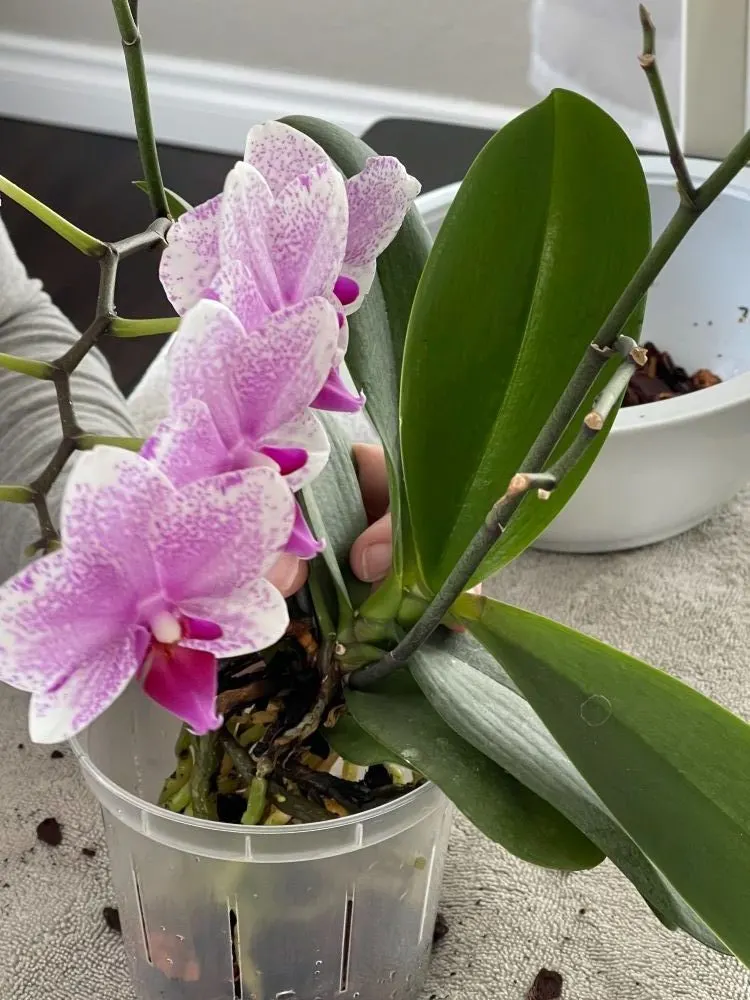
- You CAN sterilize the old soil by baking it in the oven an hour at 200 degrees F. if you have no other option. Same goes for the other substrates. Only new or sterile.
- If reusing the pot it must also be sterilized and hopefully have good drainage.
- Downsize the pot if the root ball is substantially smaller to avoid over watering in the future.
- DO NOT fertilize the plant for two months. This allows the cut roots to heal without risk of fertilizer burn. It also encourages it to grow a bigger root system as it sources nutrients.
- Finally, Trim back an amount of top growth equal to the amount of root you just trimmed off. Start with damaged and sick foliage but also trim some of the healthy leaves back as necessary. This will lighten the burden on your roots until they grow healthy again.
- If you have healthy top growth you may take a stem cutting of the plant if you can propagate it that way or pull a healthy root off the root ball and repot a section of the healthy growth.
- This will give you a chance for another plant if the old one dies off.
- And now you wait. With healthy cultivation practices you will have your best chance of reviving this plant.
Notes
Root rot can happen in any plant. but some are more susceptible than others. Be sure to keep a close eye on your watering practices to avoid future root rot.
Best Practices to Avoid Future Root Problems:
Now the we know how to fix root rot let learn How to Prevent Root Rot in the Future.
- For Leca or hydroponic growing methods DO use water with a PH of 5 to 6.5 to make sure the roots have access to oxygen. They will suffocate in hydroponic growing if they do not.
- Do NOT fertilize too heavily. Over fertilizing can damage, burn and kill roots. This allows pathogens to cause the roots to rot.
- Do NOT ever plant back into old substrate. Always use fresh or sterilized to prevent spreading the fungi and bacteria that cause rooting roots and other problems.
- Use Ceylon Cinnamon only to repel pests like fungus gnats and it is a natural fungicide as well. You can sprinkle it directly on the soil to deter gnats. And make a DIY spray as well. Go to Kaylees video (linked below) to learn how to make your own homemade cinnamon solution.
- DO Use 3 % Hydrogen peroxide for root rot prevention. It helps the plant in two ways. Hydrogen peroxide kills the pathogens that cause the root rot. Watering with a 1:1 solution of hydrogen peroxide and water will keep the soil free of them. Hydrogen peroxide also create oxygen around the plant roots. Which is a healthy thing for plants that love to be moist and are susceptible to root rot.
Follow Us:
Find us on YouTube, Instagram , Pinterest and TikTok! We love to Plant chat. We also comment, like and occasionally share your content to our daily stories. We’d love to see your plants. Share your joy in your houseplants. Happy Planting!
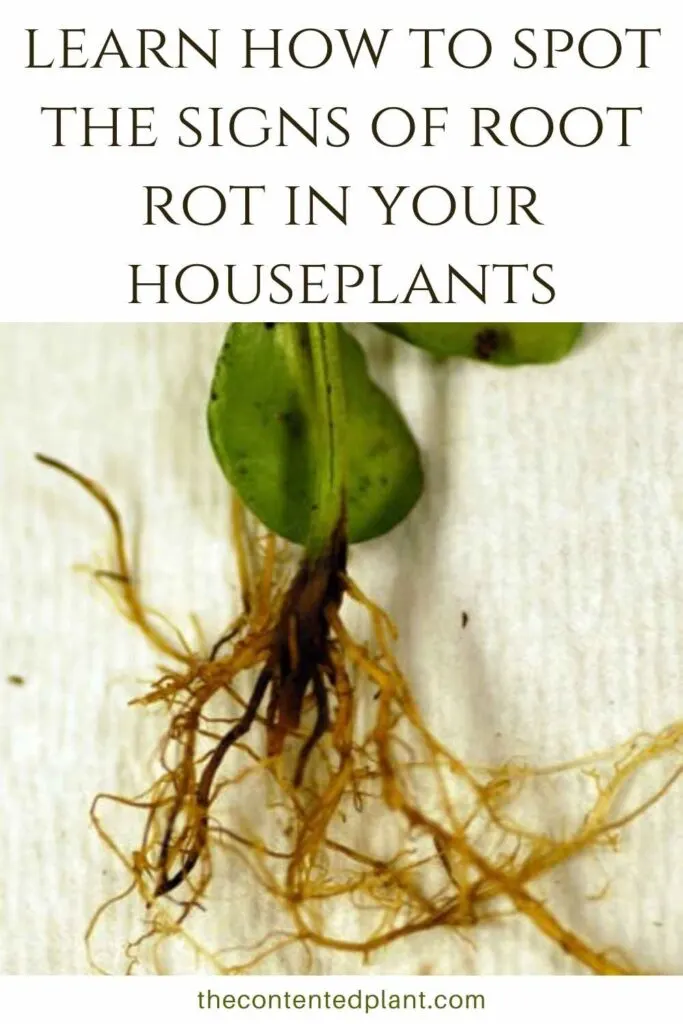
Kaylee Ellen has an informative YouTube video on root rot. Check it out!

A Simple Guide to Houseplant Care for Beginners - The Contented Plant
Saturday 6th of January 2024
[…] In nature your plant would need to sit and wait for it to rain. Our goal is to mimic nature as close as possible when caring for our plants. Watering a little bit at a time and often (multiple times a week) will put your plant at great risk for root rot. […]
Grow your Own Medicinal Herbs - The Contented Plant
Friday 29th of December 2023
[…] It is important to make sure that the plants have enough light. Proper lighting is essential for their growth and development. If you do not have a sunny windowsill, you can use grow lights or fluorescent lamps to provide the plants with the light they need. It is also important to water the plants regularly. They will need a consistent supply of moisture to thrive. But dont go crazy with watering or they will get root rot. […]
Japanese Painted Fern Care - The Contented Plant
Friday 3rd of November 2023
[…] Keep soil consistently moist, avoid waterlogging to prevent root rot […]
Peperomia Care guide And Plant Profile - The Contented Plant
Thursday 5th of January 2023
[…] They need well draining soil that won’t hold too much excess water or the plants will get root rot. […]
How To Repot A Plant - The Contented Plant
Tuesday 22nd of November 2022
[…] the plant problem and then decide if repotting is the best step forward. Sick unhealthy roots and how to fix root rot are discussed in depth in this post. If you don’t treat root rot, repotting will not save your plant. Watch me REHAB A PEACE LILY in […]